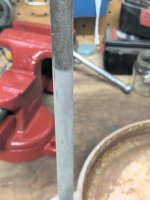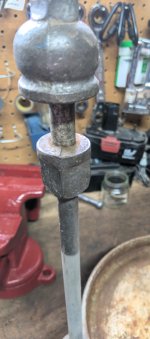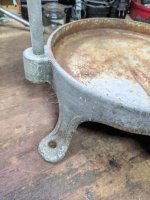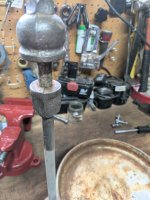Hey everyone, I'm new here, but not new to restoring cast iron. I recently picked up a fruit & lard press, similar to a Griswold No. 2 4 quart. It's nearly identical, in fact, except a few details as well as an almost total lack of markings (I see some, but they've been pretty well rubbed away, and none of them match the Griswold markings).
I was under the impression that the bulk of it was cast iron, and thus into my electrolysis tank it went. For about 3 minutes, until I saw a milky white substance coming off of it. I pulled it out, and noticed a distinct color and texture difference between what was in the tank and what was sticking out (my tank isn't deep enough for the entire thing to fit). See pictures for an example of what I mean.
The metal that was in the tank ended up gray, and feels all the world like galvanized steel. I'm now reading that these may have been galvanized cast iron, or perhaps just tinned. It's difficult to find information. Anyone know what I'm dealing with here, and what the proper method would be on this?



I was under the impression that the bulk of it was cast iron, and thus into my electrolysis tank it went. For about 3 minutes, until I saw a milky white substance coming off of it. I pulled it out, and noticed a distinct color and texture difference between what was in the tank and what was sticking out (my tank isn't deep enough for the entire thing to fit). See pictures for an example of what I mean.
The metal that was in the tank ended up gray, and feels all the world like galvanized steel. I'm now reading that these may have been galvanized cast iron, or perhaps just tinned. It's difficult to find information. Anyone know what I'm dealing with here, and what the proper method would be on this?




